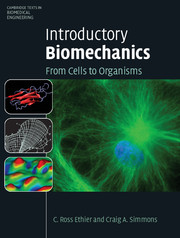Book contents
- Frontmatter
- Contents
- About the cover
- Preface
- 1 Introduction
- 2 Cellular biomechanics
- 3 Hemodynamics
- 4 The circulatory system
- 5 The interstitium
- 6 Ocular biomechanics
- 7 The respiratory system
- 8 Muscles and movement
- 9 Skeletal biomechanics
- 10 Terrestrial locomotion
- Appendix: The electrocardiogram
- Index
- Plate section
- References
9 - Skeletal biomechanics
Published online by Cambridge University Press: 05 June 2012
- Frontmatter
- Contents
- About the cover
- Preface
- 1 Introduction
- 2 Cellular biomechanics
- 3 Hemodynamics
- 4 The circulatory system
- 5 The interstitium
- 6 Ocular biomechanics
- 7 The respiratory system
- 8 Muscles and movement
- 9 Skeletal biomechanics
- 10 Terrestrial locomotion
- Appendix: The electrocardiogram
- Index
- Plate section
- References
Summary
The skeletal system is made up of a number of different tissues that are specialized forms of connective tissue. The primary skeletal connective tissues are bone, cartilage, ligaments, and tendons. The role of these tissues is mainly mechanical, and therefore they have been well studied by biomedical engineers. Bones are probably the most familiar component of the skeletal system, and we will begin this chapter by considering their function, structure, and biomechanical behavior.
Introduction to bone
The human skeleton is a remarkable structure made up of 206 bones in the average adult (Fig. 9.1). The rigid bones connect at several joints, a design that allows the skeleton to provide structural support to our bodies, while maintaining the flexibility required for movement (Table 9.1). Bones serve many functions, both structural and metabolic, including:
providing structural support for all other components of the body (remember that the body is essentially a “bag of gel” that is supported by the skeleton)
providing a framework for motion, since muscles need to pull on something rigid to create motion
offering protection from impacts, falls, and other trauma
acting as a Ca2+ repository (recall that Ca2+ is used for a variety of purposes, e.g., as a messenger molecule in cells throughout the body)
housing the marrow, the tissue that produces blood cells and stem cells.
In the following sections, we focus our discussion on the biomechanical functions of bone, and to do so we start by describing the composition and structure of bone tissue.
Information
- Type
- Chapter
- Information
- Introductory BiomechanicsFrom Cells to Organisms, pp. 379 - 443Publisher: Cambridge University PressPrint publication year: 2007
